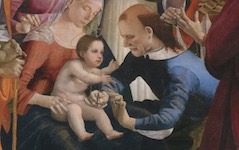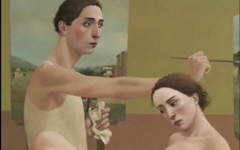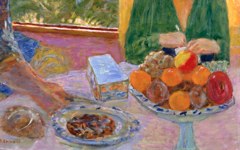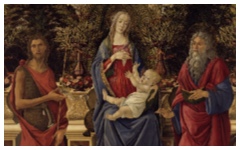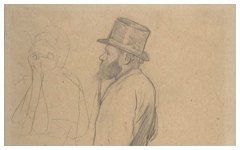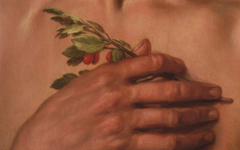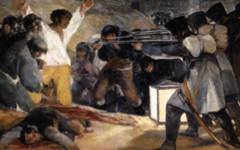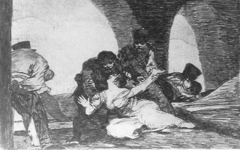The Artist with His Art
Almost all these hidden themes (few ever seen before) hark back to the idea that every painter paints himself. One of the most common is the depiction of the artist holding his or her art. Sometimes, especially in the Renaissance, the artist might represent himself as an executioner holding up the head of his victim (his “painting”) for us to see. This explains why the head of the victim is often a self-portrait. There is also an obvious pun in Italian on the word for masterpiece, capolavoro, which literally means head-work.{ref1} In other examples the artist might be in the foreground facing his “painting” which is the background painted in a different style. The two levels symbolize two different realities, the artist’s studio and the painting. In other cases, especially in the nineteenth century, the background may defy perspective, seemingly flat or vertical and thus indicating its existence in the studio as a flat, upright canvas.
1. Capolavoro was first used in Italian literature around 1700 though is likely to have been used in speech before then. A head separated from a body, though, could have been used to symbolize the artist's artwork long before then because the concept that all art is a depiction of the artist's mind was already widespread in the early Renaissance. Mind, of course, is an abstract idea long associated with the brain inside the head. See Grande Dizionario della Lingua Italiana, ed. Salvatore Battaglia, v.II (Turin: Unione Tipografico) 1961, p.708
Most Recent Articles
This painting which depicts Rembrandt crucifying Christ is an excellent example of the alternative way to read art, not viewing it as an illustration but as poetry.

Rembrandt’s Raising of the Cross (c.1633)
All Articles (Alphabetical by Artist, then Title)
Altdorfer's scene of incest is an early example of a long tradition with very similar and surprising meaning

Altdorfer’s Lot and His Daughters (1537)
Find out, even in the work of a little-known painter, how the executioner is the artist and the victim his painting.

Antonio Campi’s Martyrdom of St. Sebastian
If you keep an eye out for underlying shapes, you might even be able to guess the artist's name

Antonio da Fabriano’s St Jerome in His Study (1451)
See Artemisia Gentileschi turned a biblical story into a lesson about art and reality
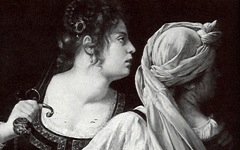
Artemisia Gentileschi’s Judith and Her Maidservant with the Head of Holofernes
Learn how one scene can turn into another through visual metamorphosis
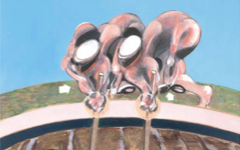
Bacon’s Two Men Working in a Field (1971)
If it looks odd, there must be a reason. See Balthus horsing around.
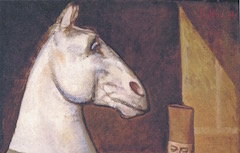
Balthus’ The Moroccan Rider with His Horse (1935)
Bandinelli's statue in Florence, known more for its competition with Michelangelo's David than for the statue itself, has lessons in it which help explain David
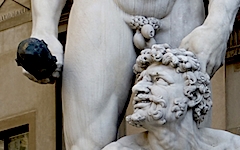
Bandinelli’s Hercules and Cacus (1525-34)
Find out how a giant Renaissance altarpiece is all about painting
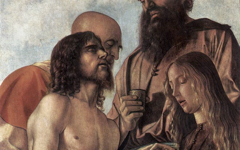
Bellini’s Pesaro Altarpiece (c. 1471/4)
How Bonnard turned his creative process into a scene in modern Paris
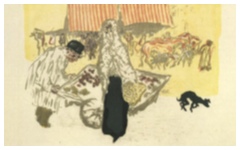
Bonnard’s The Pushcart (c.1897)
This masterpiece, like many before and since, must have been the source of inspiration for Picasso's Cubism. As unlikely as that may sound, it all depends on what you can see in The Birth of Venus that experts never have. You'll be one of the first...
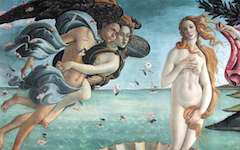
Botticelli’s Birth of Venus (1484-6): Part Two
Learn how to note passages between one level of reality and another
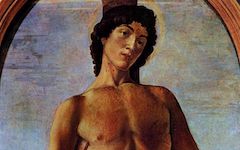
Botticelli’s St. Sebastian (c.1473)
Pastoral genre scenes, although invented by Boucher, abide by art's traditions
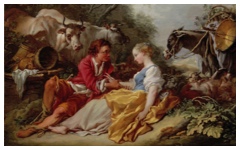
Boucher’s Pastoral landscape with a shepherd and shepherdess (c.1730)
See how Caravaggio's iconic painting makes art's basic paradigm crystal clear
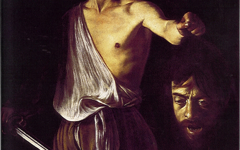
Caravaggio’s David with the Head of Goliath (1610)
See how the "artist" as St. Sebastian watches Carlo Crivelli’s Crowning of the Virgin from the side of the altarpiece.

Carlo Crivelli’s Crowning of the Virgin
If a painting looks as though there are two realities, as here, the answer is often the same

Carpaccio’s Young Knight in a Landscape (1510)
See how a divine figure is posed like a sculptor and, as an artist, executes his work

Cellini’s Perseus (1545-54)
Find out how Chagall made obvious what many other artists obscured

Chagall as an Animal (20th century)
An easy-to-recognize demonstration of how artists fuse the studio and their subject into one image

Coello’s St. Louis Worshipping the Holy Family (c.1665-8)
See how the inversion of the artist-model relationship helps express the androgyny of the artist's mind
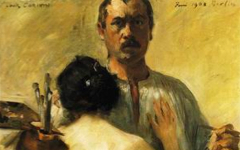
Corinth’s Self-Portrait with a Model (1903)
Find out how specialists have been on the right track too, even a contemporary.
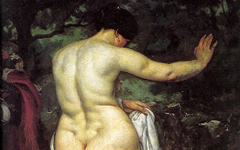
Courbet’s Corpulent Bathers: A Postscript
Yet one more artist who sees himself as an animal, even as a creating animal

Cranach’s Animals in Adam and Eve’s (1509-1533)
What can one learn from the single fragment of a larger painting? A lot, if you look.

Cranach’s Cupid (c.1530)
In Cranach’s 1506 woodcut of Venus and Cupid, Cupid is the artist drawing back the bow to shoot his “victim”.
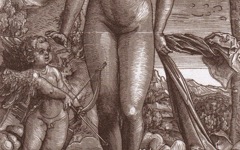
Cranach’s Venus and Cupid Woodcut
St. Veronica’s veil was the cloth with which she wiped Christ’s face after his death and on which the imprint of his face was left. The cloth with its miraculous image is here held by the angel as though it is being blown by the wind.
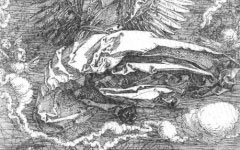
Dürer’s Angel with the Sudarium (1516)
If you can't make a sense of an image beyond what it appears to be, keep looking until you can. Come back to it, time and again, until you do.

Degas’ At the Races in the Countryside (1869)
Learn how to make sense of Degas' most mystifying composition
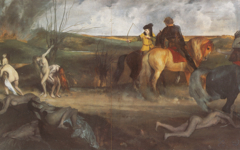
Degas’ Scene of War in the Middle Ages (c.1863-5)
When Delacroix was at last given large public rooms to decorate, he turned to Michelangelo and the Sistine Chapel

Delacroix’s Justice in Palais Bourbon (1833-7)
Another example of St. Irene "painting" St. Sebastian

Delacroix’s St. Sebastian Helped by the Holy Women (1836)
For artists St Veronica is a very significant saint. She "painted" Christ.
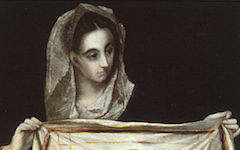
El Greco’s Saint Veronica (c.1580)
See a concise statement in mid sixteenth-century England of how every painter paints himself
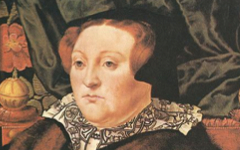
Eworth’s Mary Neville, Lady Dacre (1555-8)
Find out how a little knowledge of studio life goes a long way
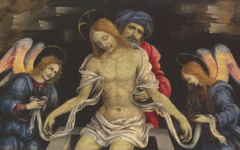
Filippino Lippi’s Dead Christ (c.1500) and the Artist’s Turban
See how one of England's most famous paintings is not what everyone thinks
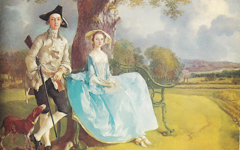
Gainsborough’s Mr and Mrs Robert Andrews (c. 1748-9)
Learn how an artist can link himself through music to great painters before him
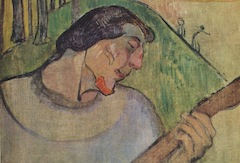
Gauguin’s Self-portrait with a Mandolin (1889) and The Player Schneklud (1894)
Conventional scholars sometimes recognize in a single work of art what we show is common in art generally.
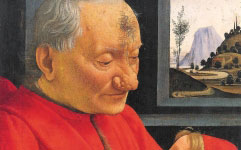
Ghirlandaio’s Portrait of an Old Man and Child (c.1490)
Even at 17, Giacometti understood the hidden meaning of art
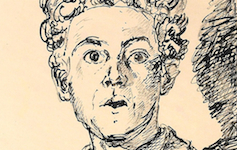
Giacometti’s Self-portrait with Brush (1918)
See how a classical legend becomes the perfect setting for an allegory on the artist's studio
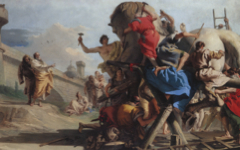
Giandomenico Tiepolo’s Building of the Trojan Horse (c.1773-4)
There has always been a violent streak to artistic creation, often expressed through military metaphor and in scenes of violence or its aftermath.
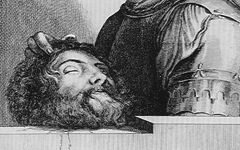
Giorgione’s Self-portrait as David
See how Goya turned a battle in the streets into a battle in his studio.....and his mind

Goya’s 2nd May, 1808 (1814)
Think about self-referential meaning and one scene can quickly turn into another
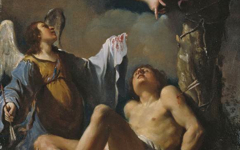
Guercino’s St. Sebastian Succoured by Two Angels (1617)
Everyone agrees that Frida Kahlo painted herself.....but within which tradition? Psychological and surrealist or esoteric?

Kahlo’s Self-Portrait with Portrait of Dr. Farill (1951)
Find out how every painter paints herself as well

Labille-Guiard’s Portrait of Madame Adélaïde (1787)
How Rivers invented (or perhaps just copied) another way an artist can symbolize the act of painting
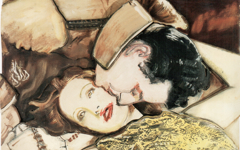
Larry Rivers’ A Vanished World: Gilbert and Garbo 1 (1994)
© Simon Abrahams. Articles on this site are the copyright of Simon Abrahams. To use copyrighted material in print or other media for purposes beyond 'fair use', you must obtain permission from the copyright owner. Websites may link to this page without permission (please do) but may not reproduce the material on their own site without crediting Simon Abrahams and EPPH.

